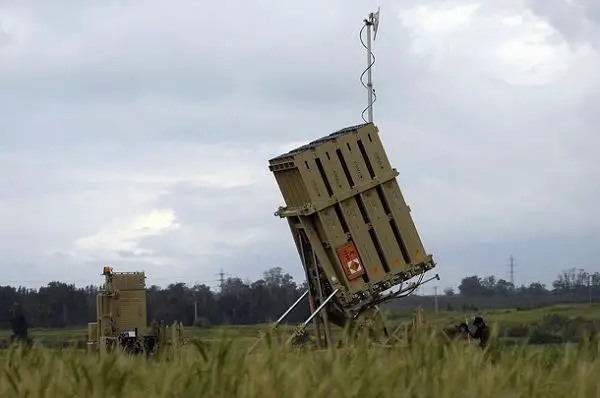Air Defense Vehicles.
Iron Dome.

The Iron Dome is an Israeli-made effective and innovative mobile defense solution for countering short-range rockets and 155 mm artillery shell threats with ranges of up to 70 km in all weather conditions, including low clouds, rain, dust storms or fog.
Country users: Israel, United States
Description
The Iron Dome is an Israeli-made effective and innovative mobile defense solution for countering short-range rockets and 155 mm artillery shell threats with ranges of up to 70 km in all weather conditions, including low clouds, rain, dust storms, or fog. The Iron Dome is developed by the Israeli Defence Company Rafael. The development of the Iron Dome began in January 2008 and is virtually complete after just two and a half years. The system uses a unique interceptor with a special warhead that detonates any target in the air within seconds. The Iron Dome is a cost-effective system that can handle multiple threats simultaneously and efficiently. The Iron Dome system has been selected by the Israeli Defense Ministry as the best system offering the most comprehensive defense solution against a wide range of threats in a relatively short development cycle and at a low cost. The Iron Dome System, which is expected to provide a defense to residents of Israel's South against rockets launched from the Gaza Strip, is entering into the final stages of performance testing and was even presented this week for the first time in an exhibition of technological weapons which was held at the Rabin military base. The Iron Dome system became operational in early 2011, initially deployed at air force bases in southern Israel. It will be set up in other areas, such as the town of Sderot, during significant escalations along the Gaza border. In November 2020, the Iron Dome entered service with the US Army. In January 2021, U.S. Army took delivery of the second Iron Dome air defense missile system from Israel. On September 22, 2022, Romania requested the purchase of the Iron Dome.
Iron Dome variants:
- C-Dome: Naval version of the Iron Dome
- Drone Dome: Version design to counter attacks of UAVs Unmanned Aerial Vehicles.
Technical Data
-
Battery
Iron Dome is composed of three fundamental elements - detection and tracking radar, battle management, and weapon control system (BMC). A missile firing unit (MFU) with 20 ready-to-fire from container launchers (three launchers for one single battery). The radar system EL/M-2084 has been developed by an Israeli defense company, Elta. The control system has been built by an Israeli software company, mPrest Systems, engaged by Rafael.
-
Missile
The missile launched by the firing unit of Iron Dome includes Tamir interceptor missiles. It has several steering fins for high maneuverability and is equipped with electro-optic sensors. The Tamir interceptor was designed for high efficiency and low cost. The missile uses elements that have already been proven in other Rafael designs and employs new components designed for others in a special warhead that detonates any target in the air within seconds. Tamir missile is 3 m long, weighs 90 kg, and has a 160 mm diameter.
-
Mobility
The Iron Dome battery components are usually carried on a 6x6 vehicle and can be rapidly placed in a position to protect strategic infrastructure targets, civilian population centers, or key military targets. Each Iron Dome battery has 20 interceptors, all of which can engage different targets at the same time.
-
Combat Use
The Iron Dome radar detects and identifies the rocket or artillery shell launch and monitors its trajectory. Target data is transmitted to the Battle Management & Weapon Control (BMC) for processing. The threat’s trajectory is quickly analyzed and the expected impact point is estimated. If the estimated rocket trajectory poses a critical threat, a command is given within seconds and an interceptor is launched against the threat.
The interceptor receives trajectory updates from the BMC via uplink communication. The interceptor approaches the target and uses its radar seeker to acquire the target and guides the interceptor within passing distance. The target warhead is detonated over a neutral area, therefore reducing collateral damage to the protected area. The Iron Dome is able to intercept and eliminate a wide range of threats as mortar shells through Hamas' Qassams, Hezbollah's Katyusha rockets and even the Fajr rockets supplied by Iran to Hezbollah and Hamas. Besides its role as a C-RAM system, Iron Dome can also provide combined C-RAM and Very Short Range Air Defense (VSHORAD) defense for air bases, military staging areas as well as coverage for maneuver units in the corps, division and brigade areas of responsibility - protecting stationary as well as mobile elements such as command posts, artillery fire units, troop concentrations, etc. A single Iron Dome battery is required to protect an urban area of approximately 150 sq km from rockets fired at a range of 15 km, with the defended area growing if the rockets are fired from greater distances.
Specifications
-
Type
Air defense missile system against short-range artillery rockets.
-
Country users
Israel, United States
-
Designer Country
Israel
-
Radar
Detection & Tracking Radar EL/M-2084
-
Firing Unit
20 container launchers each with one Tamir missile
Country users Weight Missile -
Weight Missile
90 kg
-
Length Missile
3 m
-
Missile Range
5,000 to 70,000 m
Details View












































